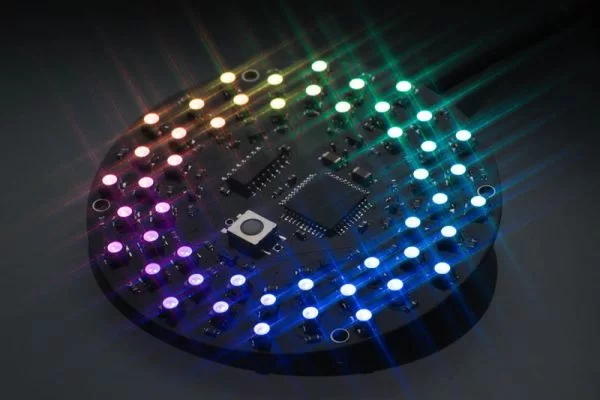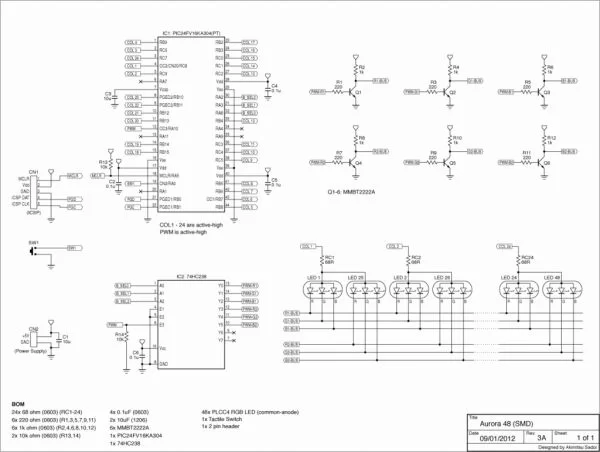Aurora 48 is a compact and thin profile full-color LED sequencer. It’s built entirely with surface mount components, so the profile is nice and clean.
Step 1: Features
- Capable of individually controlling 48 Full color LEDs.
- Each LED can be faded in 7 bit per channel – 2,097,152 colors.
- Gamma corrected brightness curve for very smooth fades.
- Simple, one button control.
- 11 sequence pattern (as of firmware version 1.0).
- Compact – 2.68 inch (68 mm) in diameter.
- Thin profile construction (0.137 inch (3.5 mm) thick).
- No leads sticking out on the back. Ideal for wearable projects.
- Firmware is easily upgradable via 5 pin ICSP connection.
Step 2: Circuit
Aurora 48 is capable of individually controlling 48 Full color LEDs using a 40 pin microcontroller. The principle of operation is based on my other “Aurora”s. (seeAurora 9×18)
The circuit is relatively simple and straightforward. If you’ve seen other LED matrix type circuit, this should look familier.
In a nutshell, the 48 RGB LEDs are divided in two groups, connected in a 6:1 multiplex fashion, taking R, G, and B as bus lines, and common pin of each LED as column lines. There are two pairs of R/G/B buses. Since there are only 3 PWM outputs available on the controller used, I used a binary decoder IC to multiplex the PWM signal, to drive 6 bus lines. 3 pins are used to select one of the 6 buses, and 24 pins are used to control LEDs’ common pins.
The controller activates one bus at a time, outputs a pulse to the LED that should be lit. The actual duration that a particular LED turns on is controlled by the PWM pulse that goes into the binary decoder, 74HC238. The controller sends PWM pulses as short as 62.5 ns to as long as 12,500 ns to control the brightness.
Step 3: Parts & PCB
[box color=”#985D00″ bg=”#FFF8CB” font=”verdana” fontsize=”14 ” radius=”20 ” border=”#985D12″ float=”right” head=”Major Components in Project” headbg=”#FFEB70″ headcolor=”#985D00″]
Here’s the parts list.
- 24x 68 ohm (0603) (RC1-24)
- 6x 220 ohm (0603) (R1,3,5,7,9,11)
- 6x 1k ohm (0603) (R2,4,6,8,10,12)
- 2x 10k ohm (0603) (R13,14)
- 4x 0.1uF (0603)
- 2x 10uF (1206)
- 6x MMBT2222A
- 1x PIC24FV16KA304
- 1x 74HC238
- 48x PLCC4 RGB LED (common-anode)
- 1x Tactile Switch
[/box]
Step 4: Assembly
Assembly is very much straightforward, that is if you are familier with surface mount soldering. Please don’t be discouraged – surface mount soldering is not difficult and can be done without special equipment. There are many instructables and YouTube how-to videos showing how to solder SMDs. With a little practice you can solder SMD very easily.
Since the PCB doesn’t have silkscreen indicating the parts, use the part placement guide provided to locate the spots for the parts.
Start with the center of the PCB and move outwards – 74HC238 and PIC24FV16KA304 would be the first ones to solder. Be sure to apply good amount of flux to the parts to be soldered. Move on to resistors, capacitors, transistors.
The LEDs are in PLCC4 package, which can be a bit tricky. PLCC’s have their leads tacked under the body (to make them smaller). They are a bit fragile against heat, so you need to solder quickly. (Again it’s not that hard, but you want to be prepared) Solder the LEDs on the outer circle first, then inner. (Ok you might prefer doing it the opposite way, but I found this way to be easier)
The tactile switch would go on last.
The two holes near C1 connect to the power supply. You can solder a 2 pin header, or solder hook up wires directly to connect to your choice of 5V power supply. I used a right angle 2 pin header here and connected a USB power cable.
Check everything, and fix as needed.
For mor detail: Aurora 48 – 48 RGB LED Sequencer



